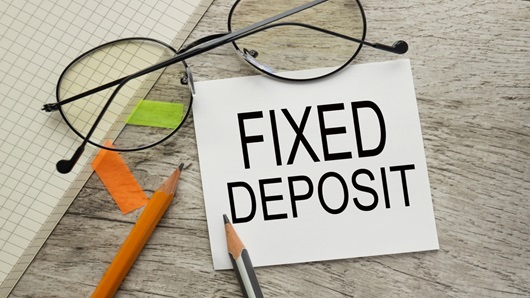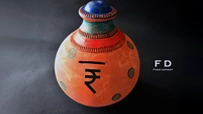How Fixed Deposits Work as Collateral for Loans
Disclaimer: The information mentioned herein is generic in nature. Please contact Ujjivan Small Finance Bank for details on OD and Loan Against FD.
September 09, 2025

Have you ever considered tapping into your Fixed Deposit when faced with financial needs? We are not talking about liquidating your FD, but using your FD as collateral to take loan or overdraft facility. This can be a smart financial move, especially in times when you need funds but don't want to disrupt your FD investments.
In this blog, we will uncover how you can use your FD collateral for loans – an underutilised strategy that offers both security and liquidity.
What is FD Collateral?
FD collateral basically means using your Fixed Deposit as a security against loan. If you face unexpected expenses or opportunities where you need funds, you don't have to withdraw your fixed deposit. Instead, you can borrow against it, ensuring that your FD investment continues to earn interest.
Benefits of Using FD as Collateral
1. Quick Loan Approval: Since it's a secured loan, the approval and disbursal process is faster compared to other loans.
2. Attractive Interest Rates: Loans against FDs generally carry lower interest rates compared to unsecured loans. The interest rate is generally 1% - 2% higher compared to your prevailing FD rates.
3. Continue Earning Interest on Deposit: Your FD keeps earning interest on deposit.
4. Flexible Repayment Options: You can repay the loan anytime before your FD maturity. There's no monthly fixed amount repayment mandate.
5. No Credit Score Check; Minimal Documentation: Since you already have an FD with the bank, all your basic details is recorded with the bank. You don't need to furnish additional documents except your basic KYC documents and FD receipt to avail the loan/overdraft.
FD as a Collateral: Eligibility and Process
Who Can Apply?
Individuals, joint account holders, societies, trusts who have an existing FD with the bank.
Steps to Secure FD Loan
1. Application Submission: Provide necessary documents like ID proof and Fixed Deposit receipts.
2. Bank Verification: The bank verifies your documents along with your fixed deposit details.
3. Loan Disbursement: Upon approval, funds are made available for use based on the predetermined percentage of your FD.
When Should You Consider This Option?
1. Sudden large expenses: Such as medical emergencies or urgent home repairs.
2. Business needs: For quick cash flow solutions.
3. Education: To fund higher education expenses without disrupting long-term savings.
For instance, if Asha needs ₹3 lakh for her MBA tuition fees but doesn’t want to liquidate her growing investments, she might consider taking a loan against her fixed deposit instead of withdrawing it entirely.
Final Thoughts
Using your FD as collateral offers a pragmatic solution when you require immediate funds but wish to keep your investments intact. It's essential to assess terms carefully and choose wisely between options like direct loans or overdraft facilities based on what suits your financial scenario best.
Looking to grow your savings? Ujjivan SFB offers a wide range of fixed deposit products. Select the FD of your choice and take a step forward to your financial goals. Alternatively, you can browse through Ujjivan SFB product suite - our wide range of financial products are designed to make your financial life better.
Disclaimer:
The contents herein are only for informational purposes and generic in nature. The content does not amount to an offer, invitation or solicitation of any kind to buy or sell, and are not intended to create any legal rights or obligations. This information is subject to updation, completion, amendment and verification without notice. The contents herein are also subject to other product-specific terms and conditions, as well as any applicable third-party terms and conditions, for which Ujjivan Small Finance Bank assumes no responsibility or liability.
Nothing contained herein is intended to constitute financial, investment, legal, tax, or any other professional advice or opinion. Please obtain professional advice before making investment or any other decisions. Any investment decisions that may be made by the you shall be at your own sole discretion, independent analysis and evaluation of the risks involved. The use of any information set out in this document is entirely at the user’s own risk. Ujjivan Small Finance Bank Limited makes no representation or warranty, express or implied, as to the accuracy and completeness for any information herein. The Bank disclaims any and all liability for any loss or damage (direct, indirect, consequential, or otherwise) incurred by you due to use of or due to investment, product application decisions made by you on the basis of the contents herein. While the information is prepared in good faith from sources deemed reliable (including public sources), the Bank disclaims any liability with respect to accuracy of information or any error or omission or any loss or damage incurred by anyone in reliance on the contents herein, in any manner whatsoever.
To know more about Ujjivan Small Finance Bank Products Visit:"https://www.ujjivansfb.in"
All intellectual property rights, including copyrights, trademarks, and other proprietary rights, pertaining to the content and materials displayed herein, belong
to Ujjivan Small Finance Bank Limited or its licensors. Unauthorised use or misuse of any intellectual property, or other content displayed herein is strictly prohibited and the same is not intended for distribution to, or use by, any person in any jurisdiction where such distribution or use would (by reason of that person’s nationality, residence or otherwise) be contrary to law or registration or would subject Ujjivan Small Finance Bank Limited or its affiliates to any licensing or registration requirements.
FAQs
1. Can I use my fixed deposit as collateral for any type of loan?
Yes, in most cases, a fixed deposit can be used as collateral for loans. Alternatively, you can opt for overdraft facility against your FD.
2. What is the loan-to-deposit ratio when using an FD as collateral?
The loan-to-deposit ratio is the maximum amount you can borrow against your fixed deposit. It typically ranges from 70% to 90% of the FD value. For Ujjivan-specific OD against FD, please contact the bank for more details.
3. Can I take loan against FD in a bank where I don't have an existing FD account?
No, you can only take a loan or overdraft with a bank where you already have an FD account.
Latest Blogs

Dussehra 2025: How to Win Your Financial Battles with Smart Saving
Dussehra 2025 (also known as Vijayadashami) falls on Thursday, October 2, 2025.

eSIM Scam in India: I4C Warns Mobile Users About Rising Fraud – How to Stay Safe
The Indian Cybercrime Coordination Centre (I4C), a wing of the Ministry of Home Affairs, issued a strong warning to mobile users about the rapid increase in eSIM fraud in India.

How to Link PAN with Aadhaar: Step-by-Step Guide & Consequences of Not Linking
Linking your Permanent Account Number (PAN) with your Aadhaar is no longer just a best practice.

Annual Information Statement (AIS): A Complete Guide for Stress-Free ITR Filing
India’s tax season is in its final stretch.

ITR-1 (Sahaj) Restrictions: Income Sources Not Allowed & Filing Rules
With just a few days left before the 15 September 2025 deadline for filing Income Tax Returns (ITRs) for Assessment Year (AY) 2025-26, many taxpayers are rushing to submit their forms online.





